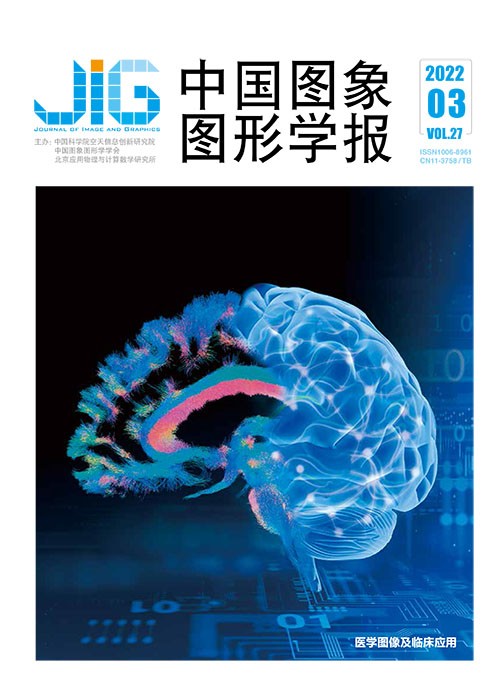
心脏动态MRI图像分割的时空多尺度网络
摘 要
目的 心脏磁共振成像(magnetic resonance imaging,MRI)的自动分割技术有利于在临床诊断中评估心脏的功能参数。然而由于心脏磁共振成像技术产生的图像边界不清晰、各向分辨率异性等特性,现有的大多数方法依旧存在类内不确定、类间不清晰问题。针对这一问题,提出了一种利用时间信息进行特征增强,并利用空间信息进行特征矫正的多输入、多分支和多任务的分割网络(spatio-temporal UNet,ST UNet)。方法 为充分获取动态心脏MRI图像的时间信息,提出了全新的时间增强编码模块,将需要进行分割的目标帧和一段包含了目标帧的连续时间片段作为关键序列一同输入网络。关键序列用于获取更丰富的时间特征,目标帧提供更精准的边缘特征。为了聚集更多有益的特征,更好地融合时域特征和边缘特征,采用可变形全局连接代替传统的长连接,为网络的解码部分提供更广泛的多维特征信息。在训练过程中额外学习空间方向场特征,并使用该特征对原有的分割结果进行矫正。结果 在ACDC (Automated Cardiac Diagnosis Challenge)心脏分割挑战中,以Dice系数和HD (Hausdorff distance)距离为评价指标,该方法在左心室、右心室和左心肌分割的平均Dice系数分别为95%、91.5%和91%,HD距离的平均值分别为6.77、11.39和8.54。结论 实验表明,提出的新型网络能够充分地利用心脏MRI图像的时空信息,有效地提升目标器官的分割效果,更有助于医生对于心脏诊断。
关键词
A spatio-temporal multi-scale network for cardiac dynamic MRI image segmentation
Xu Jiachen, Xiao Zhiyong(School of Artificial Intelligence and Computer Science, Jiangnan University, Wuxi 214122, China) Abstract
Objective The segmentation of cardiac dynamic magnetic resonance imaging (MRI) is essential to evaluate cardiac functional parameters in clinical diagnosis. Based on the segmentation results,the qualified analysis can be obtained the myocardial mass and thickness, ejection fraction, ventricular volume and other diagnostic indicators effectively. Currently, the method of heart segmentation is still limited to manual segmentation. This method is time-consuming and human behavior-oriented. Therefore, the issue of automatic and accurate cardiac-MRI (CMRI) segmentation has been focused on. However,due to the non-uniform magnetic field intensity, artifacts resulted blurred boundaries in the process of imaging. Organs of different subjects vary greatly, especially the variable shape and size of the right ventricle, which tends to produce volume effect. In addition, dynamic magnetic resonance imaging is featured based on a small scale of short axis sections with thick slice, which results in low short axis resolution and sparse information of the image. As the existing data sets only including ground truth of dynamic MRI images at two sites in the end of systole and end of diastole, the existing networks usually only take the images at these two sites as segmentation objects, which ignores the information of dynamic MRI images timescale. Hence, automatic segmentation of dynamic cardiac MRI images is challenged of the issues of intra-class uncertainty and inter-class imbalance. This illustration demonstrates a spatio-temporal multi-scale UNet that makes use of time information to conduct feature enhancement and spatial information to get feature correction. Method First, a new time-enhanced coding path is developed in order to fully obtain the time information of dynamic CMRI images, which consists of two branches are those of the target frame branch and the key sequence branch. The target frame is the image to be segmented, and the key sequence is the consistent time series containing the target frame. The key sequence is used to obtain richer time features, while the target frame provides more accurate edge features. Due to the beating frequency of the heart, the boundary information of the target organ would be in conflict with that of the time scaled images in the key sequence, and the edge information extracted from the target frame could make up for this problem. It is worth noting that the key sequence and target frame are cut or filled into 256×256 pixels due to the different sizes of images in the data set. Simultaneously, this analysis also makes the same data enhancement for the target frame and the key sequence and random affine changing and random rotation in order to extend the amount of data in the training set and improve the generalization ability and robustness of the model. Meanwhile, in order to aggregate more beneficial features and better integrate edge information and time features, this research illustrated a deformable global connection instead of the traditional long connection to provide more extensive multi-dimensional feature information for the decoding part of the network. Compared with the original network which only transfers the results of the encoding layer to the decoding layer, the features of the deformable global connection are the weighted sum of the global features. The deformable global connection is composed of the context modeling part, the feature transformation part and the deformable convolutional layer part. The part of modeling algorithm obtains the attention weight of the feature vector in the x-y plane, which represents the global context feature. The feature transformation captures the dependencies between channels to reduce the optimization difficulty via layer normalization. The deformable convolutional layer captures the geometry of the heart. In the process of decoding, the decoding layer can perform targeted aggregation to improve the compact and semantic consistency within the class based on the obtained weights. At the end, the spatial directional field features are learned and the original segmentation results are calibrated by these features. The spatial direction field, generated by ground truth, provides each pixel with a unique path from the boundary to the central region. The orientation relationship is revealed amongst the pixels on the target organ. The feature of central region is used to correct the segmentation map based on the requirement of spatial direction field. Result The online test results of the Automated Cardiac Diagnosis Challenge(ACDC) cardiac segmentation challenge illustrated that the average dice for the segmentation of left ventricle, right ventricle and left ventricle in this research analyses were 95%, 91.5% and 91% each,which is 2%, 1.5% and 2.5% higher than the initial network analysis. The average Hausdorff distance of the segmentation results is 6.77,11.39 and 8.54, respectively, which is 2.22, 2.07 and 3.64 lower than the initial network. Conclusion This demonstrated experiments show that the proposed network can improve the segmentation effect of target organs effectively based on the spatio-temporal information of cardiac MRI images.
Keywords
medical image cardiac magnetic resonance imaging(CMRI) feature enhancement spatial directional field UNet
|



 中国图象图形学报 │ 京ICP备05080539号-4 │ 本系统由
中国图象图形学报 │ 京ICP备05080539号-4 │ 本系统由